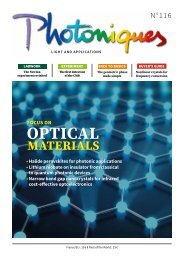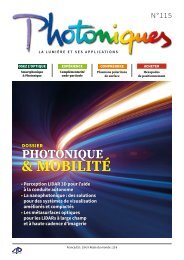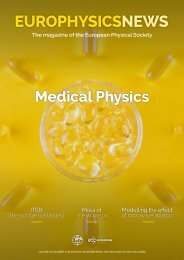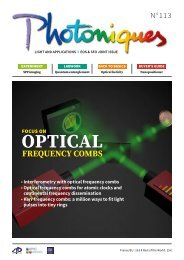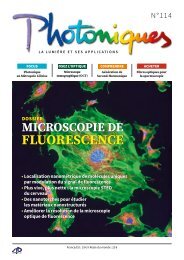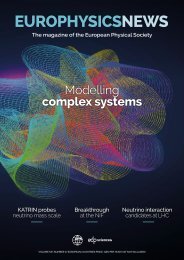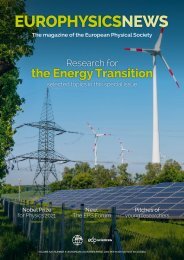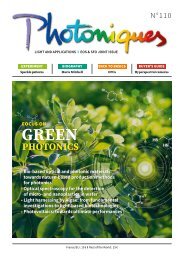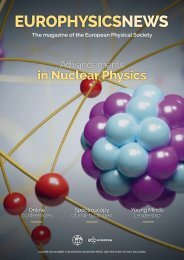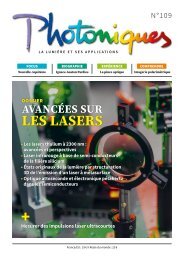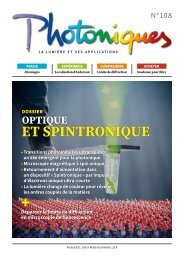Europhysics News 53-4
Europhysics News Quantum Issue
Europhysics News Quantum Issue
Create successful ePaper yourself
Turn your PDF publications into a flip-book with our unique Google optimized e-Paper software.
FEATURES<br />
molecular motor<br />
m FIG. 2: a) Schematic representation of the atomic structure of the stator (blue balls represent Pd and<br />
red ones Ga atoms) and the rotor of the motor. b) STM image of a fast-rotating C 2 H 2 molecule at 77 K,<br />
with the schematic representation of the time-averaged configuration of the rotor as inset.<br />
can induce rotation events too. Figure 4b shows the<br />
rotation rate as a function of the bias voltage between<br />
tip and sample at a constant current of 100 pA. As<br />
for the temperature dependence, we observe a sharp<br />
increase of the rotation frequency above a threshold<br />
of about 35 mV independent of polarity. In contrast<br />
to the non-directed rotation induced by temperature,<br />
the rotations induced by the STM current are<br />
directional for voltages slightly above the threshold.<br />
With increasing voltage, the direction of the rotations<br />
become progressively random. The fact that there is<br />
linear relationship between the STM current and the<br />
rotation frequency implies that a single electron transfers<br />
some of its energy to the rotor, which enables it to<br />
overcome the potential barrier between two rotation<br />
states. This is a very rare event and only about 1 out 1<br />
billion electrons flowing through the motor actually<br />
. FIG. 3: a) STM images and b) the corresponding atomistic models of one acetylene molecule on the<br />
Pd 3 :A surface in its three distinct, energetically equivalent, 60° rotated states. c) Schematic illustration<br />
of the experimental setup to probe and drive the acetylene on Pd 3 :A molecular motor with an exemplary<br />
experimental current-time sequence in d). A time-lapse movie of the rotation can be found here: https://<br />
www.youtube.com/watch?v=g7COlp6hK3A.<br />
triggers a rotation. Directionality is enabled due to<br />
friction as the rotor requires a little bit less activation<br />
energy to overcome the barrier in the CCW direction.<br />
The reason is that the trajectory in the CW direction<br />
is a bit shorter (a result of the stator being chiral) and<br />
the rotor loses less energy on this path as compared<br />
to the CW one, thus resulting in a directional rotation<br />
at low activation energies.<br />
So far, we have been discussing the classical motion<br />
of the motor and we can understand it in terms<br />
of Arrhenius' law when it is temperature activated or<br />
Newton's mechanics with friction when it is electrically<br />
stimulated. However, if we turn our attention back to<br />
Figures 4a and 4b, we see that below the threshold temperature<br />
and voltage (i.e. in the non-shaded regions<br />
of the diagrams), the rotation frequency does not decrease,<br />
but remains constant. This is the signature of<br />
the quantum-tunneling regime, which is at first glance<br />
astonishing because the acetylene rotor is massive, 26<br />
times heavier than the hydrogen atom tunneling on a<br />
copper surface. However, for the rotation it is not the<br />
mass, which is relevant but the mom ent of inertia,<br />
which is about 5.6e-46 kgm 2 . Furthermore, with 25 meV<br />
the potential barrier is small and we expect a higher<br />
tunneling rate than for H on copper. Lastly, there is also<br />
an experimental test if this can be quantum tunneling.<br />
By replacing the hydrogen atoms in the acetylene by<br />
deuterium, we increase the moment of inertia by only<br />
20%, but the tunneling rate however, drops by a factor<br />
of 4. This extreme sensitivity agrees with the theoretical<br />
expectations for quantum tunneling [7,9].<br />
Open questions, however, remain. The rotation in the<br />
tunneling regime is directional too, which is surprising,<br />
because an asymmetrically skewed rotation potential<br />
alone does not yield asymmetric tunneling rates. From<br />
fundamental thermodynamic considerations, the directional<br />
tunneling motion must be related to dissipative<br />
processes. Further investigation, e.g. by ultra-fast STM,<br />
are needed to elucidate the relationships between atomic<br />
friction and directional tunneling. n<br />
About the Authors<br />
Oliver Gröning as head and Roland Widmer as his<br />
deputy of the functional surfaces research group at<br />
Empa are engaged with research on intermetallic compounds.<br />
Harald Brune is full professor at the EPFL,<br />
where his research is concerned on novel physical and<br />
chemical properties of nanostructures at single crystal<br />
surfaces. After their PhDs at Empa, Jan Prinz is<br />
now head of the failure analysis lab team at u-blox in<br />
26 EPN <strong>53</strong>/4



